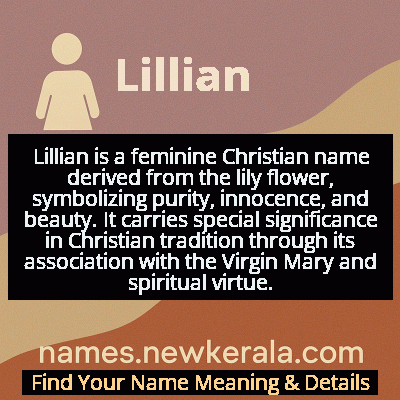Lillian Name Meaning & Details
Origin, Popularity, Numerology Analysis & Name Meaning of Lillian
Discover the origin, meaning, and cultural significance of the name LILLIAN. Delve into its historical roots and explore the lasting impact it has had on communities and traditions.
Name
Lillian
Gender
Female
Origin
Christian
Lucky Number
6
Meaning of the Name - Lillian
Lillian is a feminine Christian name derived from the lily flower, symbolizing purity, innocence, and beauty. It carries special significance in Christian tradition through its association with the Virgin Mary and spiritual virtue.
Lillian - Complete Numerology Analysis
Your Numerology Number
Based on Pythagorean Numerology System
Ruling Planet
Venus
Positive Nature
Harmonious, responsible, caring, and artistic.
Negative Traits
Overly idealistic, superficial, possessive, or jealous.
Lucky Colours
Pink, turquoise.
Lucky Days
Friday.
Lucky Stones
Diamond, turquoise.
Harmony Numbers
2, 3, 9.
Best Suited Professions
Artists, musicians, teachers, healthcare workers.
What People Like About You
Warmth, nurturing nature, artistic flair.
Famous People Named Lillian
Lillian Gish
Actress
Pioneering film actress known as 'The First Lady of American Cinema'
Lillian Hellman
Playwright
Renowned American dramatist known for 'The Children's Hour' and 'The Little Foxes'
Lillian Wald
Nurse and Activist
Founder of American community nursing and the Henry Street Settlement
Lillian Disney
Philanthropist
Wife of Walt Disney and major benefactor of the Walt Disney Company
Name Variations & International Equivalents
Click on blue names to explore their detailed meanings. Gray names with will be available soon.
Cultural & Historical Significance
The name's cultural impact expanded through literature and entertainment, with characters and real-life figures embodying different aspects of the Lillian persona. From the pioneering actress Lillian Gish to the socially conscious playwright Lillian Hellman, the name became associated with strong, creative women who broke barriers in their respective fields. This combination of traditional religious symbolism and modern feminine achievement has allowed Lillian to maintain cultural relevance across generations, adapting to changing social norms while preserving its core associations with grace and virtue.
Extended Personality Analysis
Women named Lillian are often perceived as graceful, compassionate, and intellectually curious individuals. They tend to possess a natural elegance and refinement that draws others to them, combined with a strong moral compass and sense of integrity. Many Lilians demonstrate artistic sensitivity and appreciation for beauty in various forms, from visual arts to literature and music. They are typically thoughtful communicators who value deep, meaningful relationships over superficial connections.
While often gentle in demeanor, Lilians frequently possess inner strength and resilience that enables them to navigate challenges with poise. Their combination of kindness and intelligence makes them effective problem-solvers who approach difficulties with both heart and mind. Many exhibit a nurturing quality that makes them excellent caregivers, friends, and community members. The name's floral origins seem to manifest in personalities that bloom gradually, revealing depth and complexity over time rather than immediate flashiness. This balanced combination of softness and strength, tradition and modernity, makes the Lillian personality both timeless and adaptable to various life circumstances.
Modern Usage & Popularity
Lillian has experienced a remarkable resurgence in popularity since the late 1990s, consistently ranking among the top 50 girls' names in the United States for the past two decades. The name appeals to modern parents seeking a classic, elegant name with botanical connections and historical depth that feels both traditional and fresh. Its vintage charm combined with the current trend of flower names has made it particularly attractive to contemporary families. Lillian maintains strong usage across English-speaking countries and has gained international recognition through globalization and cultural exchange. The name's versatility allows for numerous nicknames including Lily, Lil, Lila, and Lillie, contributing to its enduring appeal across generations and making it adaptable to different personality types and life stages.
Symbolic & Spiritual Meanings
The name Lillian carries rich symbolic meaning primarily derived from its connection to the lily flower. In Christian tradition, the lily represents purity, innocence, and the Virgin Mary, often called the 'Madonna Lily.' The flower's white petals symbolize chastity and virtue, while its golden stamens represent the radiance of the soul and divine grace. Beyond religious contexts, lilies signify renewal and rebirth, as they emerge from bulbs each spring, making Lillian a name associated with new beginnings and spiritual transformation. The name also conveys notions of refined beauty, grace under pressure, and quiet dignity. In various cultures, lilies are associated with motherhood, fertility, and feminine power, adding layers of symbolic depth to the name. The combination of floral elegance, spiritual significance, and natural resilience makes Lillian a name rich with positive connotations that transcend any single cultural or religious tradition.

